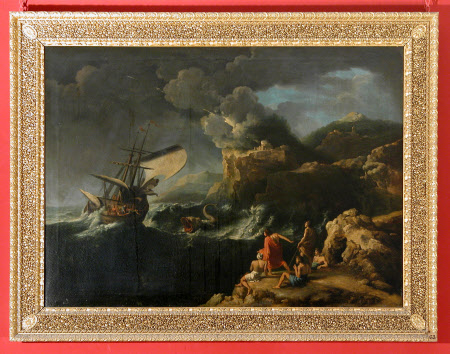Jonah and the Whale (after Dughet)
William Taverner (Canterbury 1703 – London 1772)
Category
Art / Oil paintings
Date
1745 - 1772
Materials
Oil on canvas
Measurements
978 x 1346 mm (38 1/2 x 53 in)
Place of origin
England
Order this imageCollection
Stourhead, Wiltshire
NT 732144
Caption
This biblical scene occurs in the first chapter of the Old Testament Book of Jonah. God is enraged by Jonah for neglecting to go to Nineveh to sort out its wickedness and therefore causes a great storm. Jonah is thrown overboard his ship by its frightened mates and is swallowed by a whale-like fish within whose belly he spends three days and nights praying before God commands it to vomit him out upon dry land. The story is regarded as a premonition of the sacrifice of Christ and the model for this composition was executed by Paul Bril in a 1588 fresco in the Scala Sancta, Rome. This 18th-century picture is a copy of a popular mid-17th century painting in the Royal Collection by Gaspard Dughet, brother-in-law of Nicolas Poussin, who was inspired by his style to produce symbolically dramatic depictions of moody and stormy landscapes.
Summary
Oil painting on canvas, Jonah and the Whale (after Dughet) by William Taverner (Canterbury 1703 - London 1772), 1745/72. In a storm-filled sea and rocky lanscape a sailing ship, on the left, with figures on board flounders in the huge waves. One of the figures, Jonah, who confessed that he was the cause of the storm as God was angry with him, is being thrown overboard. Beside it is a huge sea monster perched above the crest of a wave with its jaws open wide. On the rocks on the shore on the right are a group on figures watching the scene. Perched on the cliff in the distance is a temple, referring to Ninevah, the land from which Jonah has defected. This biblical story is also related in the Qu'ran. The painting is a copy after Gaspard Dughet that has been in the Royal Collection since 1745.
Provenance
Bought by Henry II Hoare (1705-85) in 1774 and thence by descent. Given to the National Trust along with the house, its grounds, and the rest of contents by Sir Henry Hugh Arthur Hoare, 6th Bt (1865 – 1947) in 1946.
Credit line
Stourhead, The Hoare Collection (National Trust)
Makers and roles
William Taverner (Canterbury 1703 – London 1772), artist after Gaspard Dughet (Rome 1615 – Rome 1675), artist
Exhibition history
Whatever the Weather, Royal Albert Memorial Museum, Exeter, 2015 - 2016

